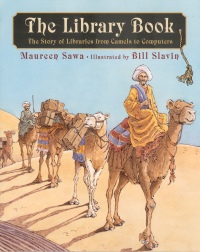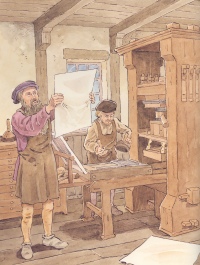| ________________
CM . . .
. Volume XII Number 20 . . . .June 9, 2006
excerpt:
Fans of libraries and bibliophiles of all ages will be charmed by Maureen Sawa's The Library Book: The Story of Libraries from Camels to Computers. In her second book, Sawa traces the rich and varied history of libraries, books and reading from the ancient world until the present. Each chapter concentrates on a different era and has a global focus, providing background information as well as historical context on libraries, books and influential figures. Chapter One discusses ancient civilizations and libraries - including Alexandria, Greece, Babylon, China and Rome. Chapter Two includes the Dark Ages, the Middle Ages and monastery libraries as well as concurrent events in the Islamic world. The third chapter, entitled "A Golden Age," recounts the revolutionary invention of the printing press, the Renaissance, the Reformation and the beginnings of the great libraries in England such as the Bodleian. In Chapter Four, Sawa’s attention turns to Benjamin Franklin, the libraries of North America as well as Andrew Carnegie and the advent of the public library as we know it today. The fifth and final chapter outlines current and future issues and initiatives in libraries around the world, including the role of technology and computers.
Highly Recommended. Elizabeth Larssen divides her time between her information services position at a local public library and her studies at the University of British Columbia in Vancouver, BC, where she is pursuing a degree in Library and Information Studies.
To comment
on this title or this review, send mail to cm@umanitoba.ca.
Copyright © the Manitoba Library Association. Reproduction for personal
use is permitted only if this copyright notice is maintained. Any
other reproduction is prohibited without permission.
NEXT REVIEW |
TABLE OF CONTENTS FOR THIS ISSUE
- June 9, 2006.
AUTHORS |
TITLES |
MEDIA REVIEWS |
PROFILES |
BACK ISSUES |
SEARCH |
CMARCHIVE |
HOME |

 While one might expect that The Library Book would be useful as supplementary material for the classroom, avid young readers and library users are sure to be enthralled by this enjoyable book. Even those young at heart will find this book charming recreational reading. Although appropriate for ages 11 and up, secondary school teachers and librarians will want to consider its purchase for use by students in grades eight and nine. The main text is accompanied by sidebars that contain fascinating morsels of trivia: "Although Muhammad pressed his followers to learn to read and write, he himself could not." The book contains both an index, as well as notes for each chapter that provide suggested further reading and websites to visit. Maureen Sawa, a librarian for the Hamilton Public Library, intuitively understands her audience and writes in a clear style that is thoroughly engrossing. The award-winning illustrator Bill Slavin provides accompanying pictures that both engage and delight while supporting the text. The Library Book: The Story of Libraries from Camels to Computers is an absolute must-have for any public or school library collection.
While one might expect that The Library Book would be useful as supplementary material for the classroom, avid young readers and library users are sure to be enthralled by this enjoyable book. Even those young at heart will find this book charming recreational reading. Although appropriate for ages 11 and up, secondary school teachers and librarians will want to consider its purchase for use by students in grades eight and nine. The main text is accompanied by sidebars that contain fascinating morsels of trivia: "Although Muhammad pressed his followers to learn to read and write, he himself could not." The book contains both an index, as well as notes for each chapter that provide suggested further reading and websites to visit. Maureen Sawa, a librarian for the Hamilton Public Library, intuitively understands her audience and writes in a clear style that is thoroughly engrossing. The award-winning illustrator Bill Slavin provides accompanying pictures that both engage and delight while supporting the text. The Library Book: The Story of Libraries from Camels to Computers is an absolute must-have for any public or school library collection.